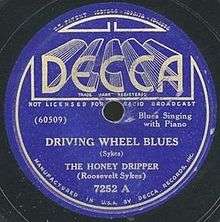Driving Wheel
"Driving Wheel", also called "Drivin' Wheel" or "Driving Wheel Blues", is blues song first recorded by Roosevelt Sykes (listed as "The Honey Dripper") in 1936. It was an influential early blues composition and has been recorded by numerous artists, including Junior Parker and Al Green, whose renditions were hits on the record charts.
| "Driving Wheel Blues" | |
|---|---|
 | |
| Single by the Honey Dripper a.k.a. Roosevelt Sykes | |
| B-side | "Barrel House Man" |
| Released | 1936 |
| Recorded | February 18, 1936 |
| Genre | Blues |
| Length | 3:06 |
| Label | Decca |
| Songwriter(s) | Unknown |
Original song
Roosevelt Sykes' "Driving Wheel Blues" is a solo twelve-bar blues, with Sykes providing piano accompaniment to his vocal. The song is performed at a medium tempo with the opening lyrics:
People, I don’t have to work and I ain’t gonna rob and steal (2×)
My baby gives me everything I need, she is my driving wheel
Sykes' recorded the song on February 18, 1936, for Decca Records.[1] It was released before 'Billboard magazine or a similar service began tracking such singles, but "Driving Wheel" is identified as influential early blues composition.[2][1]
Sykes later recorded additional studio and live versions of the song.[3] A version from the late 1940s[4] includes the opening verse with the genders reversed:
My baby don't have to work, she don't have to rob and steal (2×)
I give her everything she needs, I am her driving wheel
Renditions
Junior Parker, as "Little Junior Parker", recorded "Driving Wheel" for Duke Records in 1960 or 1961.[5] Although Parker's vocal line and lyrics follow Sykes' late 1940s version, the song uses a group arrangement with a horn section and adds a break in the middle of the song. Musician and music writer Billy Vera notes: "Fronting a horn section was really how Junior heard himself. He was a singer, not a shouter. His voice was sweet, his vibrato throbbing ... [his songs] were all more melodic than the average blues."[5]
Most subsequent versions of "Driving Wheel" show Parker's influence,[5] including the distinctive bass line. When the song was released in 1961, it spent eleven weeks on the US Billboard R&B chart, where it reached number five; it also reached number 85 in the pop chart.[6]
In 1971, soul/gospel singer Al Green recorded the song in Memphis for Hi Records.[6] His song peaked at number 46 on the R&B chart and reached number 115 on the Bubbling Under Hot 100 Singles pop chart.[6] The song is included on the 1971 Al Green Gets Next to You album[7] as well as various compilation albums. Green's version uses a different arrangement, in keeping with his soul music approach.[7]
References
- Herzhaft, Gerard (1992). "Driving Wheel". Encyclopedia of the Blues. Fayetteville, Arkansas: University of Arkansas Press. p. 445. ISBN 1-55728-252-8.
- Dahl, Bill (1996). "Roosevelt Sykes". In Erlewine, Michael; Bogdanov, Vladimir; Woodstra, Chris; Koda, Cub (eds.). All Music Guide to the Blues. San Francisco: Miller Freeman Books. p. 243. ISBN 0-87930-424-3.
- "'Drivin' Wheel' – Appears on". AllMusic. Retrieved January 8, 2016.
- arwulf arwulf. "Roosevelt Sykes: Complete Recorded Works, Vol. 9 (1947-1951) – Review". AllMusic. Retrieved August 3, 2020.CS1 maint: ref=harv (link)
- Vera, Billy (1992). Junior's Blues – The Duke Recordings Volume One (Album notes). Junior Parker. MCA/Duke Records. p. 5. MCAD-10669.CS1 maint: ref=harv (link)
- Whitburn, Joel (1988). Top R&B Singles 1942–1988. Menomonee Falls, Wisconsin: Record Research. pp. 174, 319. ISBN 0-89820-068-7.CS1 maint: ref=harv (link)
- Erlewine, Stephen Thomas. "Al Green: Gets Next to You – Review". AllMusic. Retrieved January 8, 2016.CS1 maint: ref=harv (link)